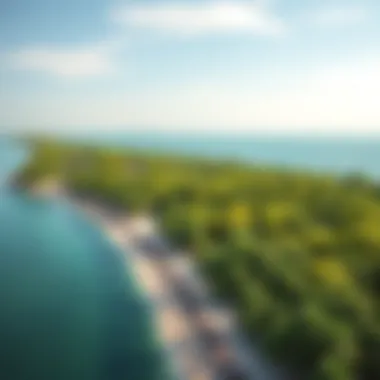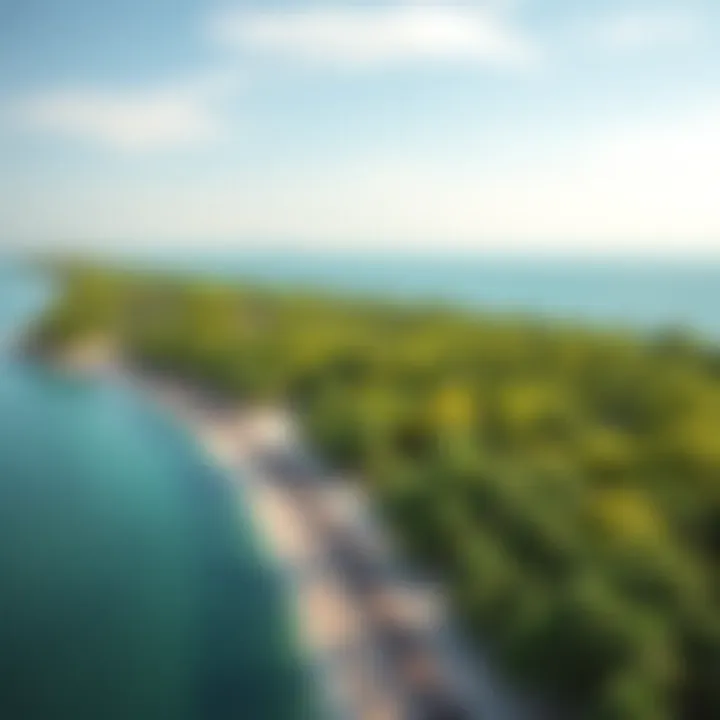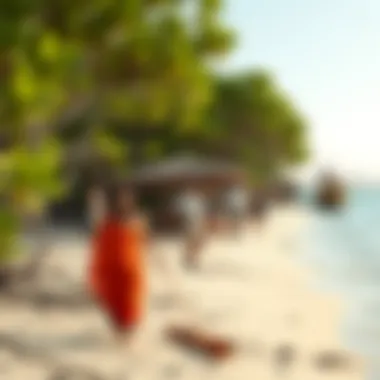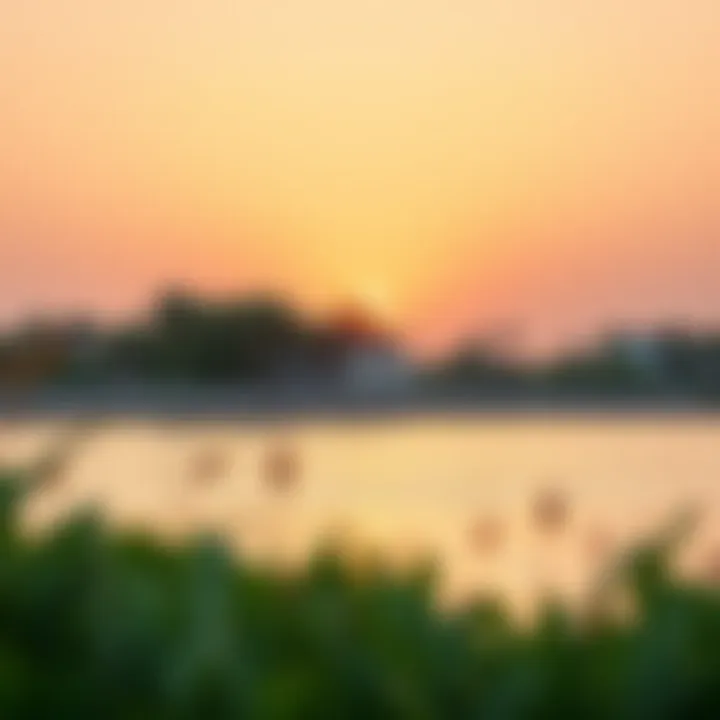Exploring the Mangrove Beach in the UAE: An In-Depth Look


Intro
The Mangrove Beach in the UAE stands as a remarkable fusion of nature and urbanization. It presents a unique ecological niche amid the buzz of modern Dubai. This area is not just scenic; it's vital for local wildlife and holds potential for sustainable tourism and real estate growth.
As we move forward in this article, we will explore the multi-faceted significance of Mangrove Beach. You will discover its ecological importance, the booming tourism sector, and how it shapes the real estate landscape. Each of these elements offers valuable insights for investors, residents, and eco-enthusiasts.
Get ready to dive into a discussion that connects the dots between natural biodiversity and real estate trends.
Prelims to Mangrove Beach
The Mangrove Beach in the UAE stands as a testament to the unique interplay between urban development and nature. Not only does it provide an essential habitat for various species, but it is also a burgeoning focal point for tourism and investment. In this section, we delve into its geographical location and historical context, offering readers an in-depth understanding of why Mangrove Beach deserves attention from investors, nature enthusiasts, and expats alike.
Geographical Location
Situated along the eastern coast of the United Arab Emirates, Mangrove Beach is nestled amid the larger backdrop of the Arabian Gulf. The distinctive feature of this coastline is its proximity to both urban centers and natural reserves. Abu Dhabi, for instance, lies just a short drive away, making it an easily accessible retreat. This region not only boasts idyllic vistas but also serves as a crucial ecological corridor, as the inlet where the mangroves breathe life into the surrounding waters.
This area is home to a myriad of flora and fauna, teeming with biodiversity. The mangroves themselves provide a natural barrier against coastal erosion, which can be particularly relevant during storms or high tides. Their role in stabilizing the coastal ecosystem cannot be overemphasized, and understanding their geographical positioning helps paint a broader picture of the beach's significance.
Historical Context
Diving into the historical context of Mangrove Beach reveals a tapestry woven with cultural and ecological significance. For centuries, indigenous communities have utilized the mangrove resources for fishing, crafting, and even traditional medicine. Their close-knit relationship with the mangroves highlights a sustainable approach to nature—one that modern society is now striving to reconnect with.
In more recent times, there have been shifts in focus toward urban expansion and recreational development. This balance between conservation and modern needs creates both challenges and opportunities. Enhanced efforts for protection and promotion of the mangroves reflect a growing recognition of their intrinsic value, not just as a tourist attraction but as a vital ecosystem.
"The real asset of Mangrove Beach lies in its ability to educate. Visitors are not just experiencing a vacation spot; they’re witnessing the intricate relationship between humans and nature."
Understanding this history sets the stage for exploring the beach's ecological importance and its potential within the tourism sector. For those looking to invest, the blend of natural beauty and rich heritage offers a compelling narrative that goes beyond mere numbers— it’s about engaging with a legacy worth preserving.
In summary, the introduction to Mangrove Beach lays a solid groundwork for understanding its multifaceted role in the UAE's ecological and economic landscape. It presents a case for why the beach should be both respected and invested in, as it represents a unique intersection of nature and humanity.
Ecological Importance of Mangroves
Mangrove ecosystems represent critical habitats that have significant ecological roles, particularly in coastal environments. Their unique qualities not only sustain local wildlife but also serve as a protective barrier against environmental threats. This section will delve into the manifold benefits and considerations regarding the ecological importance of mangroves.
Biodiversity and Habitats
Mangroves are often referred to as the 'nurseries of the ocean'. This is because they serve as vital breeding and feeding grounds for numerous marine species, including fish, crustaceans, and various birds. In the UAE, these coastal forests are home to a variety of organisms, creating a rich tapestry of life. For instance, the Avicennia marina, commonly known as the grey mangrove, thrives in these salty environments, offering a unique habitat.
Notably, the intertidal zones within mangrove forests support diverse species that have adapted to saline conditions. These habitats are crucial for juvenile fish, which ultimately aids the commercial fishing industry. Moreover, bird species such as the flamingo visit these mangroves for foraging and nesting, adding to the area's biodiversity. Thus, preserving these ecosystems ensures the sustainability of various species, many of which are integral to the food web.
Role in Coastal Protection
Mangroves perform a crucial defensive function for coastal areas. Their complex root systems stabilize shorelines, reducing erosion caused by wave action and storm surges. In recent years, the UAE has faced various climatic challenges, such as rising sea levels and intensified storms. Mangroves act as natural barriers against these threats, mitigating the impact on coastal communities and infrastructure.
Moreover, during severe weather events, the dense foliage of mangrove trees absorbs significant amounts of water, reducing the likelihood of flooding. The UAE has witnessed firsthand the destructive consequences of unprotected coastlines during storms; thus, the role of mangroves in coastal defense is invaluable. Investing in the conservation of these ecosystems could save millions in future damages, highlighting their economic importance as well as their ecological value.
Carbon Sequestration
The ability of mangroves to store carbon is increasingly recognized in the fight against climate change. They are among the most effective carbon sinks globally, trapping carbon dioxide in their biomass and sediment. The unique anaerobic conditions found in mangrove soils prevent the breakdown of organic material, which further enhances their carbon sequestration capabilities.
For every hectare of mangrove, it is estimated that approximately 1,000 to 2,000 tons of carbon can be stored over time. This presents a dual opportunity for the UAE: combating climate change while fostering a carbon credit market.
As countries grapple with their carbon footprints, UAE's investment in mangrove restoration shows promise not only for environmental health but also for a potential shift towards a more sustainable economy.


"Protecting mangroves means protecting both biodiversity and the planet's climate."
In summary, the ecological importance of mangroves cannot be overstated. They provide essential habitats, safeguard coastlines, and contribute significantly to carbon sequestration efforts. Engaging stakeholders in conservation initiatives and advocating for sustainable practices within these ecosystems is critical for future generations.
Tourism Potential
Tourism potential around the Mangrove Beach in the UAE is vast and varied, merging the rich natural environment with the allure of unique activities. This area offers not just a haven for nature lovers but also represents a significant stride toward establishing sustainable tourism practices. As the world diverges further into urban living, places like the Mangrove Beach serve as a reminder of nature's profound impacts on our wellbeing and the importance of environmental stewardship.
As travelers seek out intrinsic experiences that offer authentic insights into local ecosystems, Mangrove Beach stands at the crossroads of adventure and education. Whether it's through engaging activities or the support of local businesses, tourism here can foster immense economic growth while also focusing on conservation efforts.
Tourist Attractions and Activities
Kayaking in Mangrove Ecosystems
One of the most enticing aspects of experiencing Mangrove Beach is kayaking through its intricate waterways. This leisurely activity allows visitors to glide silently through dense mangrove forests, offering a closer look at this remarkable ecosystem. The feeling of paddling amid the lush greenery, with the sun filtering through leaves above, creates an intimate connection with nature.
Kayaking is particularly popular among tourists seeking a moment of calm away from urban chaos. The unique feature lies in the tranquility it offers; as you paddle, the serene sounds of the water and wildlife envelop you. Although some might find the narrow channels a bit challenging, the reward lies in discovering hidden corners of the mangrove that are unreachable by foot. Plus, it’s environmentally friendly, fostering a sense of responsibility with each stroke.
Wildlife Spotting Opportunities
The rich biodiversity within the Mangrove Beach's ecosystem further amplifies its allure. This area is home to numerous species, including migratory birds, fish, and even the occasional dolphin. Wildlife spotting here is not just a hobby; it’s a window into understanding the seasonal patterns that govern these habitats.
The chance to witness various species in their natural domain dovetails with conservation education. Observing a heron hunt or fish swimming through the water offers insight into their behaviors and the delicate balance of this ecosystem. However, wildlife spotting comes with its challenges, as success heavily relies on the time of day and season. The best opportunities often occur during early morning or at dusk but require a level of patience and respect for nature.
Photography and Nature Walks
For those with a creative eye, the Mangrove Beach also offers brilliant photography and nature walking experiences. The interplay of light through mangrove leaves, the reflective waters, and the multitude of colors found in both the flora and fauna create spectacular settings for capturing stunning imagery.
Walking along designated trails allows visitors to soak in the ambiance while providing plenty of opportunities for nature photography. Each step offers a new angle and perspective on the diverse plant life and the wildlife that call these mangroves home. However, potential visitors should be cautious as conditions can vary, necessitating suitable footwear and adherence to marked pathways to avoid compromising sensitive areas.
Visitor Services and Amenities
Cafes and Dining Options
After a fulfilling day of exploration, there's nothing better than relaxing in one of the cafes or dining spots scattered near Mangrove Beach. They offer visitors a chance to replenish their energy while soaking in the surrounding views. Many local eateries emphasize fresh, locally sourced ingredients, allowing guests to savor authentic flavors of the region.
The unique characteristic of these dining options is their outdoor seating, often with picturesque views of the mangroves or water. This design makes the experience special, as patrons can continue to connect with nature even while enjoying a meal. However, during peak hours, some eateries run the risk of long wait times.
Access Points and Trails
Navigating the area is another vital component of the visitor experience. Well-marked access points and maintained trails make for smooth excursions into the mangroves. These trails range from easy, leisurely walks to more intensive explorations, accommodating various preferences and physical capabilities.
The key feature of these access points is their accessibility; they allow a diverse range of visitors, including families and older adults, to engage with the environment without much hassle. On the downside, during weekends and holidays, these routes can become crowded, which might detract from the otherwise peaceful experience.
Educational Centers
Educational centers near Mangrove Beach enhance the overall experience of visitors by sharing knowledge about the significance and ecology of mangroves. These centers often offer guided tours and informative sessions that detail the importance of these ecosystems in combating climate change and supporting biodiversity.
The unique feature here is the hands-on learning opportunities, where individuals can engage directly with experts and participate in citizen science initiatives. Visitors can gain a profound understanding of their environmental impact; however, the centers’ schedules and availability can sometimes be inconsistent, leading to potential disappointments for those hoping to learn more.
Real Estate Impact
The influence of the Mangrove Beach on real estate in the UAE is profound. This area is emerging as a prime location that attracts both investors and residents due to its unique blend of natural beauty and coastal living. With the mangrove ecosystem acting as a natural barrier against harsh environmental conditions, properties situated near this area appreciate in value, making them appealing additions to any investor's portfolio.


Proximity to Properties
Proximity to the Mangrove Beach offers a set of distinct advantages that cannot be overlooked. Homes and residential developments located within a stone’s throw of this natural wonder enjoy not just picturesque views but also a serene lifestyle. Properties that are adjacent to the mangroves benefit from enhanced demand due to:
- Scenic Views: Aesthetic appeal with views of lush greenery and tranquil waters.
- Recreational Activities: Easy access to various outdoor activities like kayaking, bird watching, and nature trails.
- Positive Environmental Impact: Properties near biodiversity hotspots tend to attract buyers who prioritize sustainable living.
These factors create a higher value proposition for real estate in these areas. Buyers are increasingly looking for homes that offer more than just shelter; they want a connection with nature that enhances their quality of life.
Investment Opportunities
Investors looking for opportunities in the UAE’s real estate market should pay close attention to the Mangrove Beach area. The rapid urbanization around this natural reserve presents numerous prospects, including:
- Luxury Developments: The growing interest in high-end properties offers a chance to capitalize on upscale developments that cater to affluent buyers.
- Vacation Rentals: Given the tourism potential, investing in vacation homes or rental properties can generate significant returns. Tourists often seek comfortable and unique accommodations that are close to nature while still providing modern amenities.
- Commercial Ventures: With increasing foot traffic from both tourists and locals, commercial investments such as cafes or shops can thrive near the Mangrove Beach.
These opportunities go hand in hand with responsible development that emphasizes eco-friendliness and sustainability, making this an attractive proposition for forward-thinking investors.
Property Trends Analysis
Understanding the property trends associated with the Mangrove Beach provides essential insights for potential investors. Recent observations indicate a shift toward eco-centric living, reflecting in the property values and buyer preferences:
- Appreciation in Property Values: Properties near Mangrove Beach have seen a steady increase in value. This trend indicates a growing recognition of the area's unique landscape and its potential for a desirable lifestyle.
- Demand for Sustainable Developments: Both renters and buyers are showing a preference for properties that embrace sustainable practices, such as energy-efficient designs and materials sourced locally.
- Shift in Buyer Demographics: There is a notable increase in interest from expatriates and professionals who prioritize lifestyle quality, which has led to a diversified property market.
With a clear trajectory toward valuing environmentally conscious living, it’s pivotal for stakeholders in the real estate market to align development projects with these trends to attract discerning buyers.
"Investing in properties near Mangrove Beach is not just a financial strategy; it's an investment in a lifestyle that prioritizes harmony with nature."
By focusing on these aspects, this article highlights how the Mangrove Beach shapes the real estate landscape in the UAE, making it a focal point for investors, expats, and anyone looking to make a smart move in this vibrant market.
Conservation Initiatives
The significance of conservation initiatives at Mangrove Beach cannot be overstated. In a region where rapid development meets nature’s delicate ecosystems, these initiatives serve multiple purposes. They help preserve the rich biodiversity, enhance the liveability for local communities, and establish a sustainable framework for tourism and real estate.
Eco-Tourism and Sustainability Practices
Eco-tourism in Mangrove Beach plays a crucial role in fostering environmentally friendly practices among visitors and the local community. Not merely about offering scenic views and recreational activities, it encompasses a commitment to preserving the environment while allowing people to experience its beauty.
- Wildlife tours often explicitly educate participants about the various species inhabiting the mangrove ecosystem. Engaging guided experiences allow visitors to appreciate the subtle yet rich interconnections of life in these areas.
- Sustainable practices include using locally sourced materials for facilities, fielding expert guides to ensure minimal environmental impact, and promoting responsible behavior among visitors, such as adhering to designated pathways and not disturbing wildlife.
- Community involvement is also key. Local residents are frequently trained as eco-tour guides, serving both as stewards of the environment and as essential personnel in the thriving eco-tourism sector.
Visiting Mangrove Beach provides a deeper understanding of its ecological attributes and simultaneously enhances the livelihood of local communities.
Government and NGO Efforts
In terms of conservation, the collaborative efforts between government entities and non-governmental organizations (NGOs) can be a blueprint for success in balancing development and ecological preservation. Various stakeholders have mobilized resources to protect the fragile mangrove ecosystem through significant programs such as:
- Restoration projects are underway to rehabilitate degraded mangrove areas. This includes planting initiatives designed to restore lost mangroves and enhance the area’s natural resilience to climate change.
- Funding and resources are often allocated for scientific research that monitors biodiversity levels, assesses environmental conditions, and gauges the effectiveness of conservation measures.
- Awareness campaigns launched by NGOs help educate the public about the vital role mangroves play in maintaining coastal stability and supporting marine life. Programs usually target schools, with hands-on activities designed to foster a sense of ownership among young people.
These combined strategies have not only led to measurable improvements in mangrove health but have also drawn attention to the need for ongoing support and commitment from all community members.
"The preservation of Mangrove Beach is more than just an environmental concern; it’s a social responsibility that enriches people’s lives while safeguarding the planet's future."
In summary, the concerted efforts in the arena of conservation at Mangrove Beach illustrate how ecological health, responsible tourism, and community enrichment can intertwine seamlessly. Proper stewardship of this environment ensures that it continues to thrive for generations to come.
Cultural and Social Aspects


The cultural and social dimensions of Mangrove Beach offer a nuanced understanding of its significance beyond the ecological and economic lenses. These aspects weave the fabric of community life and highlight the multifaceted role this natural habitat plays in the local populace's lifestyle. The mangroves are not just trees by the water; they carry stories, traditions, and shared experiences that bind people together.
Traditional Use of Mangrove Areas
Traditionally, mangrove areas have served a multitude of purposes for local communities. Historically, coastal inhabitants relied heavily on these regions for fishing and gathering seafood, which shaped their diets and culinary practices. The roots of the mangroves create nurseries for fish species, making them vital fishing grounds. Additionally, certain indigenous groups have used mangrove wood for construction and crafting tools.
While these traditional uses have evolved over time, the connection between the community and the mangroves remains strong. Cultural practices often incorporate elements of the coastal ecosystem, highlighting respect and reverence for nature.
"The mangroves are a lifeline, a source of food, and a cradle of culture for many local families."
Thus, recognizing the historical significance of these areas can lead to better conservation methods that resonate with cultural preservation.
Community Engagement and Involvement
Active community engagement is pivotal in safeguarding the mangrove ecosystem. Local residents often form committees or join initiatives aimed at restoring and maintaining the mangrove areas. Workshops and educational programs—sometimes run by NGOs—enable residents to learn about biodiversity and the importance of conserving these habitats.
Partnerships between local authorities and community members can yield a host of benefits:
- Educational Outreach: Workshops educate the public on environmental sustainability and the mangrove’s contributions to coastal ecology.
- Cultural Events: Organizing events like festivals or clean-up drives fosters camaraderie and instills a sense of responsibility towards the environment.
- Volunteering Opportunities: Engaging the community in planting programs encourages local stewardship and a personal connection to the landscape.
Through these activities, communities not only protect the mangroves but also strengthen their social bonds, fostering a spirit of collaboration and mutual respect. By intertwining ecological health with cultural identity, local populations can safeguard their heritage for future generations while nurturing their environment.
Every person and event can make an indelible mark on how the mangroves are viewed, appreciated, and preserved.
Practical Considerations for Visitors
When planning a visit to Mangrove Beach, understanding practical considerations is crucial. This includes knowing when to visit, what to bring, and navigating the local environment effectively. The following insights will help potential visitors, be it investors looking to gain a foothold in the region or nature enthusiasts seeking to explore its rich biodiversity.
Best Times to Visit
Timing plays a significant role in enhancing the enjoyment of Mangrove Beach. The UAE experiences distinct seasonal variations that affect weather conditions and visitor experience. Here are some points to guide your visit:
- Winter Months (November to March): This period is often regarded as the best time to visit. With cooler temperatures averaging between 20°C to 25°C, outdoor activities become more enjoyable. Nature walks and kayaking are particularly pleasant during this time, allowing visitors to immerse themselves in the surrounding beauty.
- Spring Months (April to June): While still manageable, temperatures start to rise, averaging from 25°C to 35°C. Mornings are cooler, making this a good time for activity if you start early. However, be mindful of temperature fluctuations.
- Summer Months (July to September): The summer heat can be intense, often exceeding 40°C. For visitors undeterred by heat, early morning or late evening visits are ideal. Remember, hydration is key during these months.
Travel Tips and Recommendations
A successful trip not only hinges on the timing but also on practical preparations. Here are some handy tips that you may find useful:
- Plan Your Route: Before heading out, ensure you have a GPS or map, as some areas can be tricky to navigate. Familiarize yourself with local access points and trails.
- Pack Accordingly: Bring essentials like sunblock, water bottles, hats, and comfortable clothing suitable for outdoor activities. Binoculars could be a nice addition for those interested in wildlife spotting.
- Respect the Environment: Mangrove ecosystems are delicate. Make sure to avoid littering and adhere to local guidelines, which may include restricted areas to protect wildlife.
- Local Amenities: Familiarize yourself with local cafes and dining options. Knowing where to grab a bite or take a break can enhance your experience. Places like the Mangrove Restaurant offer not just food but a chance to relish the views.
"A little preparation goes a long way in ensuring a memorable visit to Mangrove Beach.
- Stay Informed: Check local news or community websites for any events or conservation activities happening during your visit. Engaging with the community can provide deeper insights into the region.
In summary, a visit to Mangrove Beach can be a richly rewarding experience with the right planning. By considering the optimal time to visit and preparing appropriately, visitors can dive deep into the natural charm of this unique ecological gem.
Culmination
The conclusion of this article plays a crucial role in synthesizing the array of information presented throughout. It serves not just as a recap, but as a window into the broader implications of exploring Mangrove Beach in the UAE. This piece has delved into the various facets of Mangrove Beach, providing insights into its ecological importance, tourism potential, real estate impact, and cultural significance. Such diverse layers not only highlight the value of this unique ecosystem but also shed light on how it weaves into the socio-economic fabric of the region.
Summation of Key Findings
Throughout this article, a rich narrative unfurls concerning the Mangrove Beach. Key findings include:
- Ecological Significance: Mangroves provide vital habitats for countless species, supporting biodiversity crucial for the marine ecosystem.
- Tourism Appeal: The attraction of activities like kayaking and wildlife spotting showcases the beach’s potential for eco-tourism, serving both leisure seekers and nature enthusiasts.
- Real Estate Dynamics: Proximity to Mangrove Beach has contributed to increasing interest in properties, reflecting a demand that intertwines natural beauty with investment prospects.
- Community Involvement: Engaging local communities in conservation has strengthened social ties, enhancing the overall protection of the mangroves.
In bringing these points together, we can see the intricate connections between environment, economy, and culture at play.
Future Prospects
Looking ahead, the future of Mangrove Beach appears promising yet requires thoughtful stewardship. The ongoing initiatives in eco-tourism and conservation will likely pave the way for more responsible use of these natural resources, ensuring that the ecological balance is maintained. As awareness of environmental issues grows, investors and developers may find opportunities that align with sustainable practices. Additionally, growth in community-led programs can foster deeper connections with the land and its ecosystems, benefitting not only the environment but also enhancing the cultural heritage of the area.



